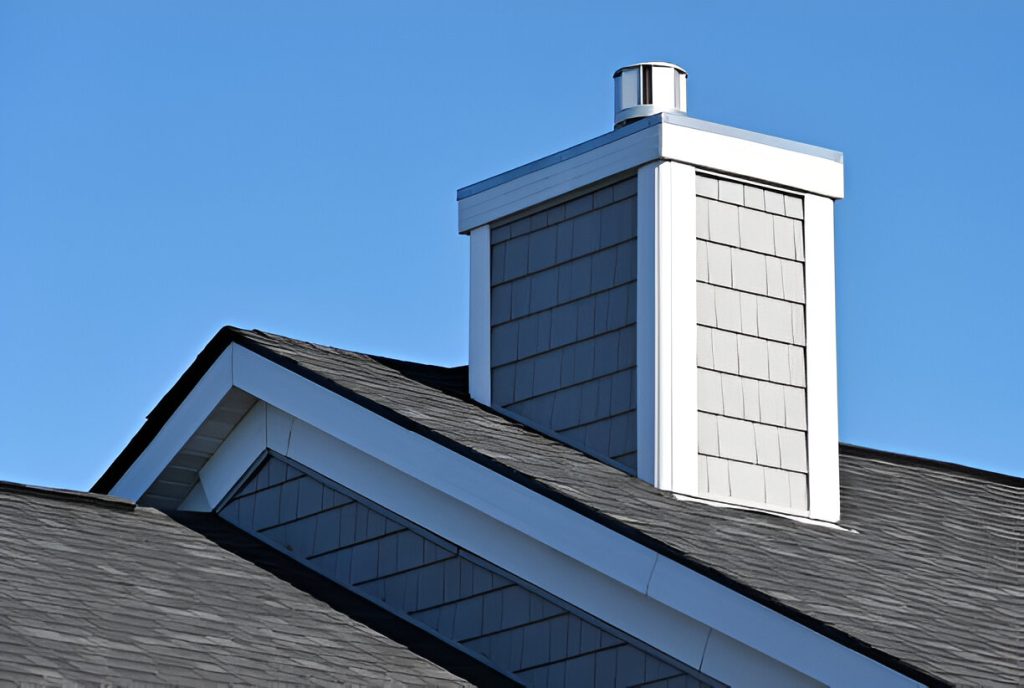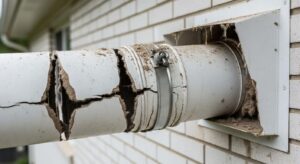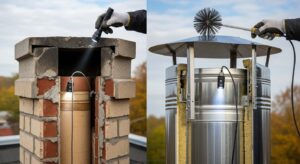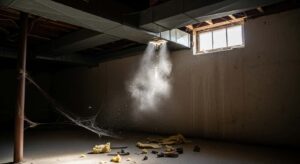How do you know your chimney liner is falling apart? You may actually be dismissing some of the common signs as inconveniences. You know, like the odd smells and the crumbling debris in your firebox. But what if these were warnings for a much bigger problem?
Although the chimney liner is supposed to keep the smoke, heat, and gases contained and away from your home structure, when the chimney liner repair is delayed, it puts your home and family at risk.
With this blog, you’ll learn 10 of the most common signs that indicate you need a chimney liner repair before it becomes a safety hazard.
Top 10 Warning Signs Your Chimney Liner May Need Repair or Replacement
It’s important to notice problems with your chimney liner before they get worse. There are your top signs that call for an immediate chimney liner repair or even replacement.
Excessive Soot Buildup or Creosote Formation
If you’re seeing excessive soot or a thick, tar-like substance called creosote, your chimney liner could be struggling. A damaged liner can cause poor airflow, which means smoke and combustion byproducts don’t escape as efficiently as they should. This causes more soot and creosote, and when it builds up even after frequent scrubbing, too much of it can ignite a small spark.
Cracks and Gaps
Ever spotted cracks in your chimney liner or little gaps that weren’t there before? It might not seem like a big deal, but over time, all that heat, moisture, and wear and tear can really take a toll. Those small cracks can actually let heat and toxic gases sneak into your walls or attic, which is the last thing you want, and it’s a serious fire risk!
Debris Falling
While cleaning your fireplace, if you find bits of tile, clay or a pile of dust and flakes, it means your chimney liner is breaking down and needs a chimney liner repair. Ignoring this can lead to bigger problems, like heat escaping through the cracks or dangerous carbon monoxide leaks. If you’re noticing this more regularly than usual, it’s time to call the professionals.
Unusual Odors
Does your fireplace smell… off? Maybe like burned wood, damp ashes, or something musty, even when there’s no fire? That’s a red flag. A well-functioning chimney liner helps direct smoke and fumes outside, but those smells can start creeping into your home when it’s damaged. Noticing persistent, smoky, or sour smells in your fireplace means your chimney liner could be failing and needs looking into for a chimney liner repair.
Trapped Smoke
Your fireplace is supposed to pull smoke up and out of your home. A damaged or deteriorating liner can disrupt airflow, making it harder for smoke to travel up and out. Instead, it gets trapped, leading to poor ventilation and even potential health risks. Breathing in too much smoke can irritate your lungs and expose you to harmful toxins like carbon monoxide
Higher Energy Bills
When your chimney liner cracks and wears out, it lets cold air sneak in during winter. This makes your heating system work overtime to maintain the indoor temperature, which means you will notice higher energy bills. After you get a chimney liner repair or replacement, the new one will keep your home cosy and the insulation intact, avoiding energy wastage.
Visible Rust or Corrosion
Rust is never a good sign, especially when it comes to your chimney. A well-functioning liner helps keep moisture out, but cracks or gaps allow water to seep in, leading to rust and corrosion. If you notice rust on your damper, firebox, or other metal parts of your fireplace, it’s a strong indicator that moisture is getting in, and that often means your chimney liner is compromised.
Deteriorating Bricks and Mortar
Your chimney liner also protects the chimney structure. When it starts failing and needs a chimney liner repair, the damage often shows up on the outside, too. Your liner may not work correctly if you see crumbling mortar, loose bricks, or white streaks. Regular inspections can catch these issues before they become major.
Fire Burns Differently
If your fires aren’t burning like they used to, maybe they’re harder to start, burn weakly, or go out too quickly. It could be due to poor ventilation caused by a damaged chimney liner. When the liner is cracked, blocked, or deteriorating, airflow gets restricted, leading to weaker flames and more smoke. Are you constantly struggling to keep a fire going? You need a chimney liner repair to deal with the hidden problem.
Animals or Pests
Hearing scratching, chirping, or rustling noises from your chimney? You might have some unexpected guests. Birds, squirrels, raccoons, and even bats often nest in chimneys, especially if gaps or cracks in the liner make it easy to get in. A damaged liner creates entry points for animals, and once they’re inside, they can cause even more damage by clawing at the liner, leaving droppings, or blocking airflow with nesting materials.
Also Read: Why is Chimney Cleaning Important for Home Safety?
Get Your Chimney Liner Inspected Before It’s Too Late
If you still think a damaged chimney liner is an inconvenience, think again. It’s a safety risk. You must deal with fire hazards, structural damage, and carbon monoxide leaks. Ignoring any of the signs we mentioned can lead to serious problems. However, you can deal with these issues before they become a headache.
Do you need a chimney liner repaired? At Alpha Clean Air, you can get a proper inspection, repair, and even replacement. Our team focuses on keeping your home safe and your fireplace functional. Contact us now to book an inspection.





